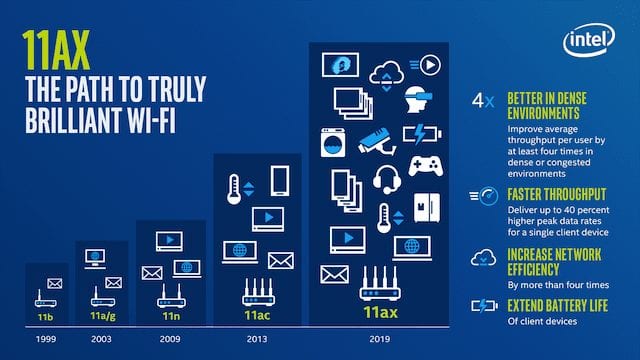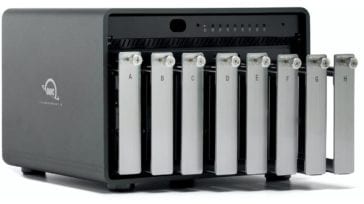
This is the third in a series of articles we’re running this month covering networking (particularly Wi-Fi) and security. The previous articles discussed Domain Name System (DNS) and how it works, as well as details of Wi-Fi Security. Today we’re taking a look forward at the upcoming Wi-Fi 6 standard and what it means to users in terms of speed and security.
Getting Rid of the Alphabet Soup
To begin with, there’s a rather simple change that the Wi-Fi Alliance — the standards group that promotes Wi-Fi technology and certifies Wi-Fi products — is making. Wi-Fi 6 won’t be marketed with the long 802.11a/b/g/n/ac alphabet soup. Instead, it’s going to be referred to as Wi-Fi 6 instead of 802.11ax. Ever wondered what that 802.11 stuff means? It’s a specification standard by the Institute of Electrical and Electronics Engineers (IEEE) for wireless local area networks in the 2.4, 5 and 60 GHz frequency bands.
By the way, there’s really no need to remember all of the 802.11 suffixes. The current crop of Wi-Fi products are now known as Wi-Fi 5, and the new faster and more secure devices are Wi-Fi 6.

What is Wi-Fi 6 and When Does It Arrive?
Wi-Fi 6 can be thought of as High-Efficiency Wireless and consists of devices that are certified to follow the IEEE 802.11ax and 802.11ay specification standards. You won’t see much about 802.11ay, but it’s part of Wi-Fi 6. It uses the 60 GHz frequency band, which has difficulty penetrating walls. As a result, we’ll focus for the rest of this article on the 802.11ax specification, which uses the more familiar 2.4 and 5 GHz frequency bands. Wi-Fi 6 also supports operation in other frequency bands between 1 and 7 GHz, which should become available soon.
It’s expected that Wi-Fi 6 products will arrive in quantity in late 2019. Manufacturers of consumer electronics have already begun to roll out products that support Wi-Fi 6 — one of the first smartphones with Wi-Fi 6 support is the Samsung Galaxy S10, released this March. It’s possible that Apple products released toward the end of 2019, such as this year’s iPhone, may include Wi-Fi 6 chipsets. The big rush to Wi-Fi 6 is expected in 2020.
Several manufacturers have already released Wi-Fi 6 routers:
Asus – with the RT-AX88U Dual Band 802.11ax Wi-Fi Router, ROG Rapture GT-AX11000 Tri-Band Wi-Fi Gaming Router, AiMesh AX6100 Wi-Fi System (RT-AX92U 2 Pack)
D-Link – has the AX11000 Ultra Wi-Fi Router DIR-X9000
Netgear – brought the first consumer Wi-Fi 6 router to market, the Nighthawk AX8 (RAX80). They also produce the Nighthawk AX12 (RAX120) and the mesh networking Orbi with Wi-Fi 6
TP-Link – Archer AX6000, Archer AX11000 Tri-Band Wi-Fi Gaming Router, Deco X10 Mesh Wi-Fi System
Of course, your devices will need to support Wi-Fi 6 in order to take advantage of the new capabilities. In the meantime, any device that works on current Wi-Fi 5 networks also works with the new Wi-Fi 6 routers as the equipment is backward compatible.

What Are The Capabilities of Wi-Fi 6?
Speed, security and better handling of multiple devices are the big new features of Wi-Fi 6. Theoretically, Wi-Fi 6 can provide speeds of up to 9.6 Gbps (approximately 10 Gigabits per second) compared to 3.5 Gbps on Wi-Fi 5. On crowded networks, throughput speeds are about four times those on existing Wi-Fi 5 networks. Latency — the amount of time required for data to travel between the sender and receiver on the network — is about a quarter of that on Wi-Fi 5 networks so there will be less perceivable lag.
Most homes in America won’t see a big difference in their Internet speeds, as very few Internet Service Providers even get to the 1 Gbps level. Where the major improvement arrives is in moving data from place to place on an internet network, say from one Mac to another, or from a future iPhone to a Mac.
Remember our discussion of WPA3 in last week’s network security article? WPA3 is a new security protocol that makes it much more difficult for hackers to crack network passwords through brute-force methods, and it makes data less useful if hackers do manage to obtain it. Well, WPA3 is required in Wi-Fi 6 devices, meaning that all Wi-Fi 6 networks benefit from stronger security.
Wi-Fi 6 is more than just about speed and security, though — it improves the network when a lot of Wi-Fi devices are connected. As more devices are connected to a Wi-Fi network, the entire network slows down. Back when Wi-Fi 5 first arrived, the average US household had about five Wi-Fi devices in it; now US homes have an average of nine Wi-Fi devices (this writer has 30 devices in his home!). By 2022, that number is expected to be closer to 50 devices per home. New technologies in Wi-Fi 6 let routers communicate with more devices at once, allow routers to send data to multiple devices at the same time, and even lets devices that don’t need to constantly be transmitting and receiving (like a home thermostat or smart door lock, for example) schedule check-ins with the network.
That last feature is called Target Wake Time, and it means that low-power Wi-Fi devices that only need to update status every once in a while can be smaller and have much-improved battery life.
What you’ll see as Wi-Fi 6 support becomes more prevalent is that your network seems faster simply because it can handle more devices simultaneously — even though average speeds per device might not necessarily be faster.
What Technologies Speed Up Wi-Fi 6?
The faster connections in Wi-Fi 6 networks are due to a pair of key technologies: MU-MIMO and OFDMA.
MU-MIMO means “multi-user, multiple input, multiple output”, and allows routers to communicate with multiple devices at the same time rather than broadcasting to one device at a time. MU-MIMO allows current routers to talk with up to four devices at a time, while the implementation in Wi-Fi 6 increases the size of the chat group to eight devices.
Adding more MU-MIMO connections is analogous to adding more delivery trucks to a fleet — each truck goes in a different direction to a different customer with a cargo of data. With Wi-Fi 5, you had four trucks in your fleet; with Wi-Fi 6 the fleet size is up to eight.
OFDMA stands for “orthogonal frequency division multiple access”, and it allows one transmission to deliver data to multiple devices at once. Using the truck metaphor, OFDMA lets one truck carry goods to multiple locations. The network can look at a truck (in reality a series of packets of data), see that a customer (a network device) only needs a certain percentage of the truck’s payload, and fill up the truck with a delivery for another customer. Each transmission from a router to a device is used more efficiently.
Do I Need To Buy All New Equipment?
To take the best advantage of the new features and capabilities of Wi-Fi 6, all devices on the network must be Wi-Fi 6 certified. Most of us don’t have the money to just replace all of our equipment, and most devices don’t even support Wi-Fi 6 yet. A good strategy for many consumers is just to start purchasing Wi-Fi 6 devices as they become widely available and affordable, then upgrade to a Wi-Fi 6 router when there are a good number of devices on the network and things start to feel sluggish.
What’s Next?
Believe it or not, the Wi-Fi Alliance is already working on plans for Wi-Fi 7, which is expected to appear in 2023. No details exist on what that specification standard will entail.









As per the comments on WPA3, serious flaws exist in the earlier spec. Firmware upgrades will be necessary.
Unless you need the features right now, or you need a new access point for other reasons, I suggest you wait a while.
The Wi-Fi alliance will probably never subject a design to open review before moving to production. As a result early adopters will need to upgrade firmware.